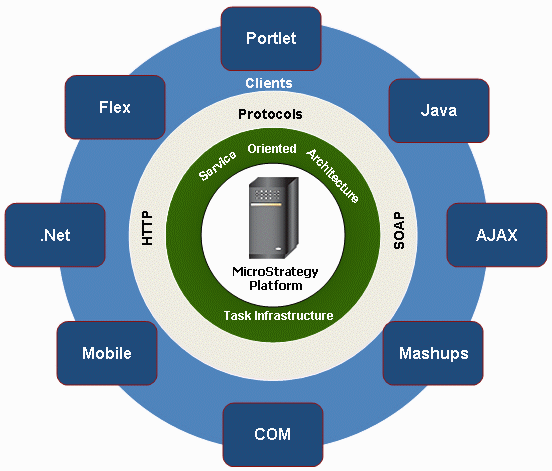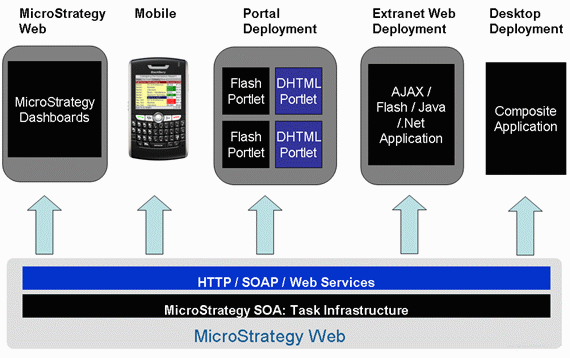Strategy ONE
Overview of Data as a Service
Using MicroStrategy BI data as a service lets you focus on how best to use the analytical power of the MicroStrategy platform to improve your applications. You can leverage the ability to create reports without writing any SQL and take advantage of features such as caching, internationalization, and security that make it easier for you to build applications that offer tremendous value to your end-users.
The best way to explain data as a service in layman's terms is to use the example of person A who wants to talk to person B. Person A can communicate with person B on the phone, by fax, through e-mail, or face to face. The way A communicates with B may differ, but the information that is being communicated remain the same. Similarly, an application can connect to MicroStrategy in many ways, but the report execution is exactly the same.
To use this analogy to understand how data as a service works, imagine that you have information that you want to provide to a number of different recipients. Some of the recipients have a computer, others have only a fax machine, and still others have neither. For the first group, you can send the information via email over the Internet. For the second group, you can send the information via fax over the phone lines. For the third group, you can send the information via mail using the Postal Service. In each case, the source of the information is the same (you) and the information being sent is the same. What differs in each case is the method used to deliver it and thus the protocol and format associated with that method.
It is also possible that the recipients in this example may want the information presented differently. Some of the email recipients may want the information as numbers in the body of the e-mail, others may want an Excel spreadsheet attached to the email, and still others may want the PDF version of the Excel spreadsheet as an attachment. In response to these varying requests, you—as the one source of the information—produce the same set of information, but simply supply it in a different format. Again, the source of the information and the information itself do not change. Only the way the information is formatted and processed is different.

The ability to provide BI data as a service is supported by MicroStrategy Web's service-oriented architecture (SOA) and Task Infrastructure. In the SOA paradigm, MicroStrategy acts as the analytical platform to deliver content to multiple applications, allowing you to retrieve BI data from MicroStrategy and incorporate it into your line of business applications using a variety of interfaces. You can access core MicroStrategy functionality through the Intelligence Server API (that is, the COM API), Web API, URL API, Task API, Web Services API, Distribution Services API, and Command Manager. The power and flexibility of its service-oriented architecture allows MicroStrategy to achieve loose coupling among interacting software agents by providing interfaces that consumers can use to access the desired functionality.

In service-oriented architecture (SOA), discrete chunks of functionality are built as services that can be accessed by many applications in many different ways. In MicroStrategy Web, these services are called tasks. Applications can make a task call to MicroStrategy Web to request BI data on the fly. For authentication, applications can pass the session state to a task as a parameter, or they can pass a set of credentials that can be used to log in. Once they are authenticated, the applications can then run a report, convert the data to a specific format, send it back to the client, and log out. Tasks can be configured to use a specific style to format the data that is retrieved by the service. The style applied to render data can use one of the many out-of-the-box transforms provided by MicroStrategy, or it can use a custom transform that has been created by extending and customizing an existing transform.

The introduction of Flex, SilverLight, and other programmable environments has made it easier to build custom solutions that are rich with diverse information—including business intelligence to help end users make critical and timely business decisions. The ability to use data as a service lets you leverage reports you have already created in MicroStrategy by adding them to your custom applications. In addition, you can use any of the available APIs to provide data in the specific format required by your client application. The end result is that you can build your application once and then use it with any protocol and on any client.

See also
